crater
 During World War II, there were hundreds of thousands, if not millions, of bombs dropped across Europe. There is no way to know where they were dropped, or if they actually exploded, or worse yet, if they are still lurking beneath the surface waiting to detonate. Princess Diana was a champion of a similar cause, but she was concerned about landmines…just as deadly, but a different deployment. Both concerns are real, and both situations are deadly. One German bomb specialist said that the problem will haunt Europe for centuries, saying, “There will still be bombs 200 years from now.”
During World War II, there were hundreds of thousands, if not millions, of bombs dropped across Europe. There is no way to know where they were dropped, or if they actually exploded, or worse yet, if they are still lurking beneath the surface waiting to detonate. Princess Diana was a champion of a similar cause, but she was concerned about landmines…just as deadly, but a different deployment. Both concerns are real, and both situations are deadly. One German bomb specialist said that the problem will haunt Europe for centuries, saying, “There will still be bombs 200 years from now.”
One such example is that of the German town of Limberg, whose residents woke up to a startling sight on the morning of June 23, 2019. A crater in a field as large as a house. The explosion was caused by a leftover bomb from World War II. Unexploded bombs really are a huge problem in Germany and other European countries, because these long-buried weapons periodically surface or spontaneously explode. No one knows when it might happen and the aftermath can be devastating. The explosion occurred in the central German town of Ahlbach, just north of Frankfurt. Residents reported hearing and feeling a large explosion in the early morning hours of Sunday the 23rd, but no one actually saw the explosion occur. During a follow-up the next day, they found a crater 33 feet wide and 14 feet deep in the middle of a barley field. It was determined that a decomposing bomb detonator for the explosion.
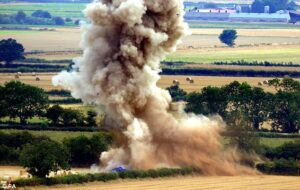
According to the BBC, “explosive ordnance demolition teams concluded that the explosive device was a 551 pound aerial bomb dropped by the Allies during World War II. The bomb was likely a M43, AN-M43, or AN-M64 500 pound general purpose bomb. General purpose bombs at terminal velocity will penetrate 3-4 building stories before detonating, so it’s not surprising this bomb buried itself so well.”
“The M65 was five feet long and 14 inches wide, and carried a payload of 280 pounds of TNT. The bomb casing, designed to produce fragment into lethal shrapnel, was .3 inches thick. An explosive ordnance disposal guidebook describes their purpose as to destroy ‘steel railway bridges, underground railways, sea craft such as light cruisers, concrete docks, medium sized buildings, etc.’”
During World War II, Germany operated several facilities in areas important to the war effort, including Limburg Field and an important railroad junction and marshaling yard. Allied bombs were dropped during the war, but often missed by miles. Falling at a high rate of speed, that morning’s bomb buried itself in the soft soil and 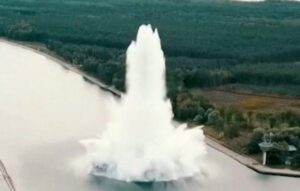 remained undetected for decades. Whoever cultivated the barley field obviously had no idea 280 pounds of highly unstable explosives lurked underneath, and thankfully no one was hurt
remained undetected for decades. Whoever cultivated the barley field obviously had no idea 280 pounds of highly unstable explosives lurked underneath, and thankfully no one was hurt
Seventy five years after the end of World War II, unexploded bombs are still a huge problem not only in Germany, but across all of Europe. The explosions don’t happen often, but when one explodes the results can be devastating. Governments are trying to find these bombs. Experts drill holes and look for bombs using magnetometers, searching for the signature of a bomb’s steel casing. Then they defuse or explode them harmlessly.
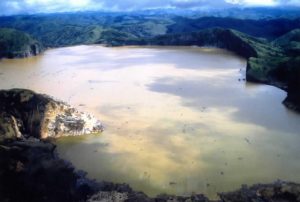 Natural disasters happen all the time…every day for that matter. Many of these disasters cannot be predicted, or can only be predicted a few minutes to hours before the disaster arrives. That was not the case with the Limnic eruption that happened at Lake Nyos in Cameroon, on August 21, 1986…or was it. A Limnic eruption is a eruption of gas rather than lava or ash, and the gasses can be deadly.
Natural disasters happen all the time…every day for that matter. Many of these disasters cannot be predicted, or can only be predicted a few minutes to hours before the disaster arrives. That was not the case with the Limnic eruption that happened at Lake Nyos in Cameroon, on August 21, 1986…or was it. A Limnic eruption is a eruption of gas rather than lava or ash, and the gasses can be deadly.
The eruption of lethal gas came from Lake Nyos at 9:30pm on that August day in 1986, took the lives of 2,000 people in the nearby villages, including Lower Nyos. The eruption wiped out four villages too. Carbon Dioxide, while natural to the earth, and even a part of the life process, becomes deadly if there is too much of it. Because Lake Nyos and Lake Monoun are crater lakes, the possibility exists for gasses to escape from the volcanos below them. The lakes are both about a mile square, and are located in the remote mountains of northwestern Cameroon. The area is beautiful with great rock cliffs and lush green vegetation.
Prior to the eruption, there were signs of impending disaster. In August 1984, 37 people near Lake Monoun died suddenly, but the incident was largely covered up by the government. The remoteness and lack of services made the incidents easier to cover up. Since there is no electricity or telephone service in the area, it was not difficult to keep the incident under wraps, and the 5,000 people who lived in villages near Lake Nyos simply had no idea that there was a very real danger of their own lake producing the same dangerous gas. I’m not 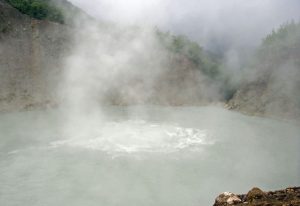 certain why they would want to keep the matter a secret, other that to avoid causing a panic, but the plan was fraught with disaster. Had the people known, maybe they could have left the area and survived.
certain why they would want to keep the matter a secret, other that to avoid causing a panic, but the plan was fraught with disaster. Had the people known, maybe they could have left the area and survived.
When scientists first began to be able to predict natural disasters, they were afraid the tell people that there was a problem. Then, after many people lost their lives from what could have been an avoidable disaster, most governments began to see the value of early warnings. The 37 people who lost their lives had no chance of a warning. There were no signs of that eruption, but if the government hadn’t hidden the facts, the 2,000 people who died when lake Nyos had its eruption, might have had a chance. At the very least, they could have made an educated decision about whether to stay or to go. Of course, with two years between the eruptions, they might have ignored the warnings too.
When the rumbling noise from the lake began at 9:30pm, and continued for 15 to 20 seconds, followed by a cloud of carbon-dioxide, and a blast of smelly air, it was too late for those people. The cloud quickly moved north toward the village of Lower Nyos. Some people tried to run away from the cloud, but they were later found dead on the paths leading away from town. The only two survivors of Lower Nyos were a woman and a child. The deadly cloud of gas continued on to Cha Subum and Fang, where another 500 people lost their lives. The carbon dioxide killed every type of animal, including small insects, in its path, but left buildings and plants unaffected, because plants use carbon dioxide as part of the growth cycle.
Reportedly, even survivors experienced coughing fits and vomited blood. Outsiders only learned of the disaster  as they approached the villages and found animal and human bodies on the ground. The best estimate is that 1,700 people and thousands of cattle died. A subsequent investigation of the lake showed the water level to be four feet lower than what it had previously been. Apparently, carbon dioxide had been accumulating from underground springs and was being held down by the water in the lake. When the billion cubic yards of gas finally burst out, it traveled low to the ground–it is heavier than air–until it dispersed. Lake Nyos must now be constantly monitored for carbon-dioxide accumulation. Hopefully that will prevent further disasters like these from happening again.
as they approached the villages and found animal and human bodies on the ground. The best estimate is that 1,700 people and thousands of cattle died. A subsequent investigation of the lake showed the water level to be four feet lower than what it had previously been. Apparently, carbon dioxide had been accumulating from underground springs and was being held down by the water in the lake. When the billion cubic yards of gas finally burst out, it traveled low to the ground–it is heavier than air–until it dispersed. Lake Nyos must now be constantly monitored for carbon-dioxide accumulation. Hopefully that will prevent further disasters like these from happening again.
 Because our world seems always to be at war, it is an unfortunate reality that bombs will exist…some legal, made for our military to keep us safe, some legal to blow up things for construction and other things, and of course some illegal, meant to bring terror and destruction. When I think about most bombs, the word terror definitely comes to the surface…be the bomb legal or not. Never is that more of a thought that when I think about the possibility of a bomb being lost, especially due to a plane crash. During the Cold War, as a means of maintaining first-strike capability, United States bombers carrying nuclear weapons circled the earth constantly…for decades. We just never knew when we could be attacked. We had to be…always ready.
Because our world seems always to be at war, it is an unfortunate reality that bombs will exist…some legal, made for our military to keep us safe, some legal to blow up things for construction and other things, and of course some illegal, meant to bring terror and destruction. When I think about most bombs, the word terror definitely comes to the surface…be the bomb legal or not. Never is that more of a thought that when I think about the possibility of a bomb being lost, especially due to a plane crash. During the Cold War, as a means of maintaining first-strike capability, United States bombers carrying nuclear weapons circled the earth constantly…for decades. We just never knew when we could be attacked. We had to be…always ready.
The problem with planes carrying bombs and in the air constantly, is the possibility of crashes. My thought, when a bomber crashes, is what happens to the bomb. In all reality, it’s a good question. There have been about three dozen accidents in which bombers either crashed or caught fire on the runway, resulting in nuclear contamination from a damaged or destroyed bomb and/or the loss of a nuclear weapon. We don’t often hear about these…especially when they happen in the United States, but let one happen in another country, and it’s a different story. When one of these bombs was lost, it was called a Broken Arrow, mainly to avoid panic, I’m sure. One of the only Broken Arrows to receive widespread publicity occurred on January 17, 1966. A B-52 bomber crashed into a KC-135 jet tanker over Spain.
The bomber was on route to its base in North Carolina, when the crash occurred dropping three 70 kiloton hydrogen bombs near the town of Palomares and one in the sea. The KC-135 was attempting to refuel the B-52, when the B-52 collided with the fueling boom. The fuel was ignited and the KC-135 blew up, killing its crew. Four of the seven crew members of the B-52 managed to parachute to safety…the rest were lost. The bombs were not armed, but with the first two, the explosive material exploded on impact, forming craters and scattering radioactive plutonium over the fields of Palomares. One bomb landed in a dry riverbed and remained intact, and the fourth landed in the sea. No one knew for sure where it was. The cleanup was massive.
Locating the bomb that had fallen into the sea took a bit longer. The Navy used an IBM computer, and experts tried to calculate where the bomb might have landed. They were very handicapped because of the size of the 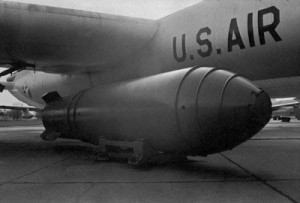 impact area. Finally, a Spanish fisherman gave an eyewitness account that proved to be so accurate that on March 15th, with a much smaller search area, a submarine spotted the bomb. The bomb was recovered on April 7th, damaged but intact, and everyone breathed a sigh of relief. This particular accident was widely reported, because it was on foreign soil. It makes me wonder why there is so little reporting on American soil Broken Arrows. To this day, two hydrogen bombs and a uranium core lie in yet undetermined locations in the Wassaw Sound off Georgia, in the Puget Sound off Washington, and in swamplands near Goldsboro, North Carolina. I suppose some people knew of these lost bombs before, but I did not…until now.
impact area. Finally, a Spanish fisherman gave an eyewitness account that proved to be so accurate that on March 15th, with a much smaller search area, a submarine spotted the bomb. The bomb was recovered on April 7th, damaged but intact, and everyone breathed a sigh of relief. This particular accident was widely reported, because it was on foreign soil. It makes me wonder why there is so little reporting on American soil Broken Arrows. To this day, two hydrogen bombs and a uranium core lie in yet undetermined locations in the Wassaw Sound off Georgia, in the Puget Sound off Washington, and in swamplands near Goldsboro, North Carolina. I suppose some people knew of these lost bombs before, but I did not…until now.

